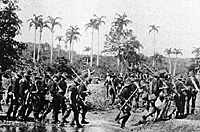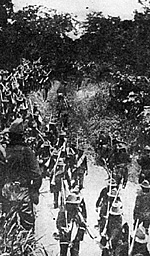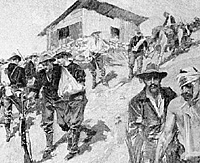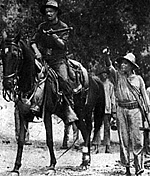Las Guasimas
Friday 24th June,while empty troop transports took on board Cubans to transfer them from Aserraderos to Siboney, Lawton's Division acting under orders received from Shafter moved north of its encampment and started its march from Sevilla. This plan was for Lawton's division to lead the advance inland, but Wheeler was having none of it. He considered it was his duty to take on active reconnaissance of the Spanish situation, so by pulling rank on Lawton, he exceeded his authority and pushed on ahead against the Spanish.
 Only one of his troops had its horses still with it, the rest marching and fighting dismounted. Roosevelt's Rough Riders were now dubbed as the 'Weary Walkers'. Despite all this, and with the dense bush in the region preventing extensive operations by mounted troops anyway, the Cavalry Division pressed on. Wheeler had directed General Samuel Young to move out early in the morning with a force of 1,000 men, and to take the junction of two roads truthfully little
more than tracks near an old sugar mill at a place known as Las Guasimas.
Only one of his troops had its horses still with it, the rest marching and fighting dismounted. Roosevelt's Rough Riders were now dubbed as the 'Weary Walkers'. Despite all this, and with the dense bush in the region preventing extensive operations by mounted troops anyway, the Cavalry Division pressed on. Wheeler had directed General Samuel Young to move out early in the morning with a force of 1,000 men, and to take the junction of two roads truthfully little
more than tracks near an old sugar mill at a place known as Las Guasimas.
The force comprised of four troops of the 1st US Regular Cavalry and four troops of the 10th US Cavalry, black soldiers that had an abundant experience in Indian warfare. Also with the force were 500 men of the 1st US Volunteer Cavalry, Roosevelt's Riders and four Hotchkiss quick firing mountain guns and crews. The regulars with the guns were to take the valley road to the junction, while the Rough Riders were to march up the direct road, straight over the hill and onto Las Guasimas itself.
 The ground from recent rainfall was soft underfoot. The bush they encountered everywhere was made up of the fiercest cactus and thorns yet encountered spotted here and there by groves of palms. Cuban and American scouts led the way for both columns. About two miles out from
Siboney, the American column halted to gauge the Spanish positions that had heen sighted on a hill north of the junction of the two roads. Here emplaced in trenches and rifle pits was Colonel Alcaniz with six companies of infantry and a machine gun with crew.
The ground from recent rainfall was soft underfoot. The bush they encountered everywhere was made up of the fiercest cactus and thorns yet encountered spotted here and there by groves of palms. Cuban and American scouts led the way for both columns. About two miles out from
Siboney, the American column halted to gauge the Spanish positions that had heen sighted on a hill north of the junction of the two roads. Here emplaced in trenches and rifle pits was Colonel Alcaniz with six companies of infantry and a machine gun with crew.
The Americans immediately brought up their Hotchkiss artillery and emplaced it just to the west of the valley road that Young had been marching along. Young withheld the order to fire until he was sure Wood, Roosevelt and the Volunteers had gained enough ground on the left flank. At 0720 hours the American artillery opened up on the Spanish positions at about 1200 yards, and was immediately answered by long accurate volleys from the Spanish infantry that killed one of the gun crew almost in the first few shots. The four troops of the 1st Cavalry started to slowly work their way through the dense tangle of bush towards the front slope of the hill.
One of the troops made its way along the stream running along Young's left. On gaining a position within 1000 yards of the Spanish, the US troops opened fire on the hill. Again they were answered immediately by long sweeping fire from the machine gun and rifles, and in the leading troop of the 1st Cavalry, the Captain, Lieutenant and Senior Sergeant were cut down. Young saw his advance slow, and committed his 10th Cavalry, one troop up the stream to strengthen his left, and two troops to the right. The Spanish fire had been so effective, Young believed the Spanish intended to flank him. He kept the fourth troop as his last reserve, with himself on the road.
Rough Riders into Action
 The Rough Rider column (post battle, at right) had its own firefight to deal with. Moving up the hill road the ascent had been steep and in some places very slippery. In the lead was Captain Alwyn Capron, at 28 a
regular Lieutenant from the 7th Cavalry that had received a Captain's commission in the 1st US Volunteers, and Sergeant Hamilton Fish, a young wealthy New York socialite who had enlisted in the ranks of the Rough Riders. The fact that these two characters marched side by side
was just one of the many peculiarities of this campaign the professional soldier and the reckless spirit.
The Rough Rider column (post battle, at right) had its own firefight to deal with. Moving up the hill road the ascent had been steep and in some places very slippery. In the lead was Captain Alwyn Capron, at 28 a
regular Lieutenant from the 7th Cavalry that had received a Captain's commission in the 1st US Volunteers, and Sergeant Hamilton Fish, a young wealthy New York socialite who had enlisted in the ranks of the Rough Riders. The fact that these two characters marched side by side
was just one of the many peculiarities of this campaign the professional soldier and the reckless spirit.
Word was sent back to Colonel Wood that the enemy was up ahead. Wood and Roosevelt deployed their troops either side of the road, leaving three troops in reserve. A reinforcement was sent forward at the double to assist Capron and his troop. Within minutes the Spanish, at close range and hidden in the scrub, opened fire. Fish was killed outright, and Capron fell mortally wounded beside him. Another dozen men were felled by the Spaniards' second volley, killing Sergeant Marcus Russell, another socialite volunteer and friend of Hamilton Fish, who was leading up the reinforcement. Only one of the advance party made it back to the Rough Rider lines, blinded by his own troops deployed either side of the road now opened up on the Spanish, and slowly working their way forward, discarding blanket rolls and even water bottles they forced the Spanish to begin a withdrawal.
However, twice the Spanish stood and fired volley after volley to hold up the Rough Riders advance through the scrub. Two of the reserve troops were sent by Wood to connect with Young's left flank in the stream bed, while Roosevelt himself took command of the Riders' left flank. The battle had now raged for an hour with both columns engaging the Spanish to their fronts, both columns oblivious to what was going on to their flanks. The Spanish troops carried on a dogged retreat in the face of both American advances and eventually the companies that had opposed the Rough Riders from the hill rejoined Alcaniz on the hill. Now they prepared for their final withdrawal to the defences around Santiago by first moving through Sevilla.
News of the engagement arrived in Siboney by one of the scarce mounted couriers, just as wounded American casualties started appearing on the road. Lawton dispatched some infantry reinforcements up the road to Las Guasimas to bolster the fighting line buy they arrived as the battle wound itself up. As the 1st cavalry had made its way to the more open ground near the junction, the two troops of the 10th Cavalry on the American right flank had charged uphill to take the ground from which the Spanish machine gun had just retired from. On the Americans' extreme left, with three troops of Rough Riders and a rifle in his hands, Roosevelt had rushed the dilapidated sugar mill where one band of Spanish were trying to conduct a rearguard. The Spanish were ejected and fled off towards Sevilla, and the Americans had won their first engagement.
Losses
As an encouragement to the men's morale the action at Las Guasimas was a good opening for the regulars and volunteers under Young, Wood and Roosevelt, but the losses had been heavy. The initial force engaged was 964 officers and men. The Americans had lost 16 killed and 52 wounded. American accounts stated that they should have inflicted two hundred casualties. According to a report from Captain General Blanco to Madrid, Alcaniz lost 7 killed and 27 wounded. Considering the Spanish fought from cover, initiated a fighting withdrawal after the first contact and quit their positions in terrain that prevented an effective pursuit to be carried out, not to mention the lack of adequate mounted American troops to conduct such a pursuit, the losses suffered by the Spanish are probably accurate. They retired through Sevilla and took up post by the San Juan river that runs into the sea near Aguadores.
 Opposing them, General Adna Chaffee's 3rd Brigade from Lawton's division moved up and formed a strong defensive line in the face of the Spanish troops. Behind them, the rest of the US 2nd division bivouacked, with Wheeler establishing his headquarters at Las Guasimas, his field of glory. Near Siboney lay General Kent's 1st Division with the majority of the heavy artillery bogged down on the beach. Still onboard the Seguranca, General Shafter wrestled with the options he now faced. Wheeler had won his little battle and had guaranteed his front page of glory in the American papers but at what cost?
Opposing them, General Adna Chaffee's 3rd Brigade from Lawton's division moved up and formed a strong defensive line in the face of the Spanish troops. Behind them, the rest of the US 2nd division bivouacked, with Wheeler establishing his headquarters at Las Guasimas, his field of glory. Near Siboney lay General Kent's 1st Division with the majority of the heavy artillery bogged down on the beach. Still onboard the Seguranca, General Shafter wrestled with the options he now faced. Wheeler had won his little battle and had guaranteed his front page of glory in the American papers but at what cost?
 Original plans laid down by Sampson and Shafter had encompassed an advance up the coastline, with the A.E.F. supported by the US Navy all they way, culminating in an assault or investment of the city of Santiago. However, Wheeler's skirmish at Las Guasimas was to change the whole
campaign. Shafter, eager for the army to gain more credit in this Cuban venture than the Navy, now allowed Wheeler, Lawton and Kent to concentrate the troops for a push inland and away from the Navy's assistance. Admiral Sampson was distinctly annoyed at the diminishment of the Navy's role, and from here onwards, relations between Shafter and Sampson were strained. Admiral Cervera was still blockaded in Santiago's harbour, and between the American Expeditionary Force and General Linares lay the San Juan heights and El Caney.
Original plans laid down by Sampson and Shafter had encompassed an advance up the coastline, with the A.E.F. supported by the US Navy all they way, culminating in an assault or investment of the city of Santiago. However, Wheeler's skirmish at Las Guasimas was to change the whole
campaign. Shafter, eager for the army to gain more credit in this Cuban venture than the Navy, now allowed Wheeler, Lawton and Kent to concentrate the troops for a push inland and away from the Navy's assistance. Admiral Sampson was distinctly annoyed at the diminishment of the Navy's role, and from here onwards, relations between Shafter and Sampson were strained. Admiral Cervera was still blockaded in Santiago's harbour, and between the American Expeditionary Force and General Linares lay the San Juan heights and El Caney.
US Campaign for Santiago Continued
-
Part I: Background
Part II: Provocation
Part III: Send in the Marines and AEF
US Campaign for Santiego Map
Order of Battle
Back to Colonial Conquest Issue 11 Table of Contents
© Copyright 1996 by Partizan Press.
This article appears in MagWeb (Magazine Web) on the Internet World Wide Web.
Other military history articles and gaming articles are available at http://www.magweb.com